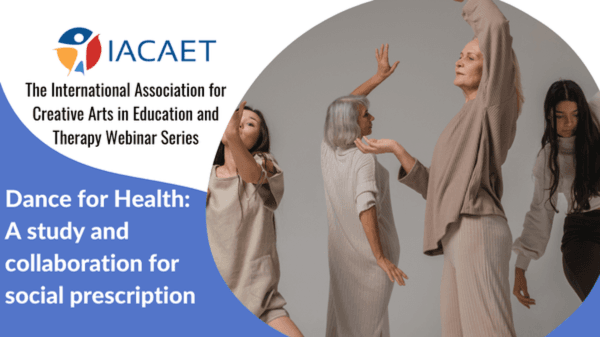Dance for Health: A Study and Collaboration for Social Prescription Webinar

This webinar discusses the results of a 10-week study on a spectrum of dance engagement with 191 diverse aging adults.
Our global population is aging and often accompanied by a myriad of psycho-physical changes, requiring tailored interventions to promote overall health and wellbeing. In the pursuit of enhancing the quality of life of aging adults, it is imperative to adopt strategies and environments that are both adaptive and sensitive to their unique circumstances. One innovative method gaining traction is the adaptive use of dance, which offers myriad benefits beyond the conventional approach to senior care. This creative solution addresses both psycho-physical health and wellbeing including loneliness.
Loneliness and social isolation, two of many non-medical or social determinants of health, drive nearly all Americans over 50 to interact with the healthcare system (Fink, et al., 2021). "Thus, older people who have chronic conditions, experience loneliness or are at risk of social isolation may benefit substantially from social prescribing" (p.5, WHO, 2022).
Community services in dance and the arts are expanding through collaboration of public and private organizations and university initiatives to fulfill the social 'prescriptions' from healthcare providers. Columbia College Chicago (CCC) in partnership with RUSH University—Systems for Health and the City of Chicago Department of Family and Support Services collaborated on a study that sought to understand what dosage, activity types, program design, and delivery, would improve health outcomes for the aging adult and provide recommendations for the health professional's social prescribing toolkit. Funded by the National Endowment for the Arts (NEA) the study called, Dance for Health: A spectrum of dance engagement for the psycho-physical health and wellbeing of aging adults, examined 5 domains including biometrics, balance and mobility, physical activity, wellbeing and perception of engagement. Over 10 weeks three interventions were implemented with 197 diverse participants at six regional community senior centers. These interventions provided a developing understanding of key factors including the activity types from passive, active receptive, and active co-creative engagement, design, delivery and dosage of dance.
Through a series of interconnected explorative and causal implementation screenings data was quantitatively collected and measured through numerous standardized tools and qualitatively investigated through thematic analysis of the post-Focus groups.
Dance for Health is a developing model of one social prescribing collaboration. The Dance for Health four study questions and their results will be shared, with recommendations for healthcare providers and program developers to create arts services with a lasting impact for aging adults.
Dance for Health Research Study — The Dance Center Columbia College Chicago
Fink, B., Bläsing, B., Ravignani, A., Shackelford, T.K. (2022). Evolution and functions of human dance. Evolution and Human Behavior. Volume 42, Issue 4, 2021, 351-360.
World Health Organization. Regional Office for the Western Pacific. (2022). A toolkit on how to implement social prescribing. WHO Regional Office for the Western Pacific. https://iris.who.int/handle/10665/354456. License: CC BY-NC-SA 3.0 IGO

